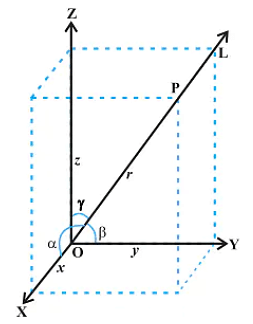Let the plane 2x + 3y + z + 20 = 0 be rotated through a right angle about its line of intersection with the plane x – 3y + 5z = 8. If the mirror image of the point
\((2,−\frac{1}{2},2) \)
in the rotated plane is B( a, b, c),then
Let the plane 2x + 3y + z + 20 = 0 be rotated through a right angle about its line of intersection with the plane x – 3y + 5z = 8. If the mirror image of the point
\((2,−\frac{1}{2},2) \)
in the rotated plane is B( a, b, c),then
\(\frac{a}{8}=\frac{b}{5}=\frac{c}{-4}\)
\(\frac{a}{4}=\frac{b}{-5}=\frac{c}{-2}\)
\(\frac{a}{8}=\frac{b}{-5}=\frac{c}{4}\)
\(\frac{a}{4}=\frac{b}{5}=\frac{c}{2}\)
The Correct Option is A
Solution and Explanation
The correct answer is (A) : \(\frac{a}{8}=\frac{b}{5}=\frac{c}{-4}\)
Consider the equation of plane,
P : (2x + 3y + z + 20) + λ(x – 3y + 5z – 8) = 0
P : (2 + λ)x + (3 – 3λ)y + (1 + 5λ)z + (20 – 8λ) = 0
∵ Plane P is perpendicular to 2x + 3y + z + 20 = 0
So, 4 + 2λ + 9 – 9λ + 1 + 5λ = 0 ,vso λ=7
P :9x – 18y + 36z – 36 = 0
Or P :x – 2y + 4z = 4
If image of \((2,−\frac{1}{2},2)\)
in plane P is (a, b, c) then
\(\frac{(a−2)}{1}=\frac{(b+\frac{1}{2})}{−2}=\frac{(c−2)}{4 }\)
and \(\frac{(a+2)}{2}−2(\frac{b−\frac{1}{2}}{2})+4(\frac{c+2}{2})=4\)
Clearly
\(a=\frac{4}{3},b=\frac{5}{6} and \) \(c=−\frac{2}{3} \)
So, a :b : c = 8 : 5 : – 4
Top Questions on Three Dimensional Geometry
- If $(\alpha, \beta, \gamma)$ is the foot of the perpendicular drawn from a point $(-1,2,-1)$ to the line joining the points $(2,-1,1)$ and $(1,1,-2)$, then $\alpha+\beta+\gamma=$
- TS EAMCET - 2025
- Mathematics
- Three Dimensional Geometry
- If m:n is the ratio in which the point $\left(\frac{8}{5}, \frac{1}{5}, \frac{8}{5}\right)$ divides the line segment joining the points (2,p,2) and (p,-2,p) where p is an integer then $\frac{3m+n}{3n}=$
- TS EAMCET - 2025
- Mathematics
- Three Dimensional Geometry
- If A(2,1,-1), B(6,-3,2), C(-3,12,4) are the vertices of a triangle ABC and the equation of the plane containing the triangle ABC is $53x+by+cz+d=0$, then $\frac{d}{b+c}=$
- TS EAMCET - 2025
- Mathematics
- Three Dimensional Geometry
- Let $\pi_1$ be the plane determined by the vectors $\hat{i}+\hat{j}, \hat{i}+\hat{k}$ and $\pi_2$ be the plane determined by the vectors $\hat{j}-\hat{k}, \hat{k}-\hat{i}$. Let $\vec{a}$ be a non-zero vector parallel to the line of intersection of the planes $\pi_1$ and $\pi_2$. If $\vec{b} = \hat{i}+\hat{j}-\hat{k}$ then the angle between the vectors $\vec{a}$ and $\vec{b}$ is
- TS EAMCET - 2025
- Mathematics
- Three Dimensional Geometry
Show that the following lines intersect. Also, find their point of intersection:
Line 1: \[ \frac{x - 1}{2} = \frac{y - 2}{3} = \frac{z - 3}{4} \]
Line 2: \[ \frac{x - 4}{5} = \frac{y - 1}{2} = z \]
- CBSE CLASS XII - 2025
- CBSE Compartment XII - 2025
- Mathematics
- Three Dimensional Geometry
Questions Asked in JEE Main exam
Let one focus of the hyperbola \( H : \dfrac{x^2}{a^2} - \dfrac{y^2}{b^2} = 1 \) be at \( (\sqrt{10}, 0) \) and the corresponding directrix be \( x = \dfrac{9}{\sqrt{10}} \). If \( e \) and \( l \) respectively are the eccentricity and the length of the latus rectum of \( H \), then \( 9 \left(e^2 + l \right) \) is equal to:
- JEE Main - 2025
- Conic sections
- Let \( \alpha_1 \) and \( \beta_1 \) be the distinct roots of \( 2x^2 + (\cos\theta)x - 1 = 0, \ \theta \in (0, 2\pi) \). If \( m \) and \( M \) are the minimum and the maximum values of \( \alpha_1 + \beta_1 \), then \( 16(M + m) \) equals:
- JEE Main - 2025
- Maxima and Minima
- Let the line \( x + y = 1 \) meet the circle \( x^2 + y^2 = 4 \) at the points A and B. If the line perpendicular to AB and passing through the midpoint of the chord AB intersects the circle at C and D, then the area of the quadrilateral ABCD is equal to:
- JEE Main - 2025
- Coordinate Geometry
- The number of different 5 digit numbers greater than 50000 that can be formed using the digits 0, 1, 2, 3, 4, 5, 6, 7, such that the sum of their first and last digits should not be more than 8, is:
- JEE Main - 2025
- permutations and combinations
- Two identical symmetric double convex lenses of focal length \( f \) are cut into two equal parts \( L_1, L_2 \) by the AB plane and \( L_3, L_4 \) by the XY plane as shown in the figure respectively. The ratio of focal lengths of lenses \( L_1 \) and \( L_3 \) is:

Concepts Used:
Three Dimensional Geometry
Mathematically, Geometry is one of the most important topics. The concepts of Geometry are derived w.r.t. the planes. So, Geometry is divided into three major categories based on its dimensions which are one-dimensional geometry, two-dimensional geometry, and three-dimensional geometry.
Direction Cosines and Direction Ratios of Line:
Consider a line L that is passing through the three-dimensional plane. Now, x,y and z are the axes of the plane and α,β, and γ are the three angles the line makes with these axes. These are commonly known as the direction angles of the plane. So, appropriately, we can say that cosα, cosβ, and cosγ are the direction cosines of the given line L.
